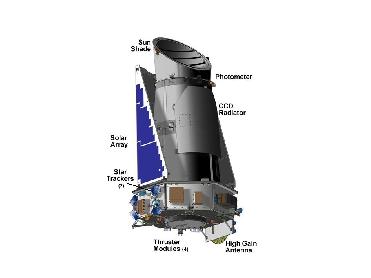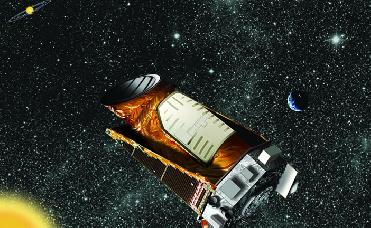
Engineering rendering of Kepler spacecraft. Image credit: NASA
The centuries-old quest for other worlds like our Earth has been rejuvenated by the intense excitement and popular interest surrounding the discovery of hundreds of planets orbiting other stars. There is now clear evidence for substantial numbers of three types of exoplanets – gas giants, hot-super-Earths in short period orbits, and ice giants.
The next challenge is to find terrestrial planets (i.e., those one half to twice the size of the Earth), especially those in the habitable zone of their stars where liquid water might exist on the planet’s surface.
The Kepler Mission is specifically designed to survey the Milky Way galaxy to discover hundreds of Earth-size and smaller planets in or near the habitable zone and determine the fraction of hundreds of billions of stars in our galaxy that might have such planets. Its scientific objective is to explore the structure and diversity of planetary systems.
The Kepler instrument is a specially designed 0.95-meter diameter telescope called a photometer or light meter. It has a very large field of view for an astronomical telescope – 105 square degrees, which is comparable to the area of your hand held at arm's length. It needs that large a field in order to observe the necessary large number of stars. It stares at the same star field for the entire mission and continuously and simultaneously monitors the brightness of more than 100,000 stars for the life of the mission which is 3.5 or more years.
The photometer must be space-based to obtain the photometric precision needed to reliably see an Earth-like transit and to avoid interruptions caused by day-night cycles, seasonal cycles and atmospheric perturbations, such as, extinction associated with ground-based observing.
Results from the mission will allow scientists to place our solar system within the context of planetary systems in the Galaxy. -- Courtesy: NASA
 Previous Article
Previous Article Next Article
Next Article













The Indian Air Force, in its flight trials evaluation report submitted before the Defence Ministry l..
view articleAn insight into the Medium Multi-Role Combat Aircraft competition...
view articleSky enthusiasts can now spot the International Space Station (ISS) commanded by Indian-American astr..
view article